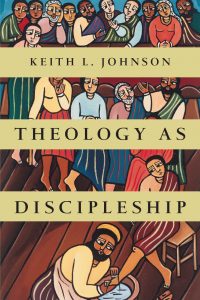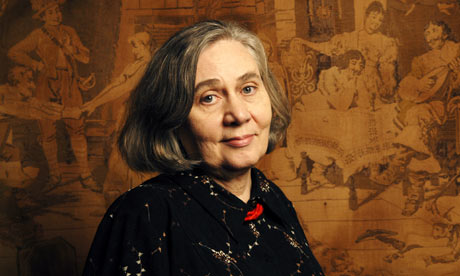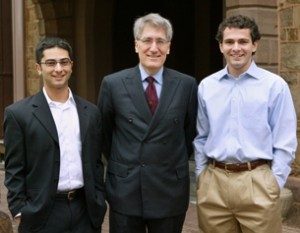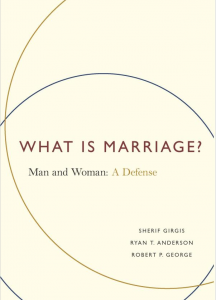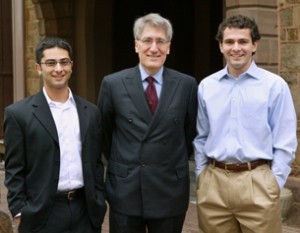 What is Marriage? Man and Woman: A Defense (New York: Encounter, 2012) by Sherif Girgis, Ryan T. Anderson, and Robert P. George, began its life as an article in the Harvard Journal of Law and Public Policy (Vol. 34, No. 1, Winter 2010, 245-287), which was both well received and heavily contested. The book is an expansion of the original article as well as a response to the discussion which arose in the aftermath of the article. At the time of publication Girgis and Anderson were doctoral candidates at Princeton and Notre Dame Universities respectively, while George was Visiting Professor at Harvard Law School and Professor of Jurisprudence at Princeton University. The authors also present their argument in person at a Wheatley Institute lecture.
What is Marriage? Man and Woman: A Defense (New York: Encounter, 2012) by Sherif Girgis, Ryan T. Anderson, and Robert P. George, began its life as an article in the Harvard Journal of Law and Public Policy (Vol. 34, No. 1, Winter 2010, 245-287), which was both well received and heavily contested. The book is an expansion of the original article as well as a response to the discussion which arose in the aftermath of the article. At the time of publication Girgis and Anderson were doctoral candidates at Princeton and Notre Dame Universities respectively, while George was Visiting Professor at Harvard Law School and Professor of Jurisprudence at Princeton University. The authors also present their argument in person at a Wheatley Institute lecture.
The book is relatively short (xiv + 133 pages) and comprises six chapters together with an introduction, conclusion, and appendix. It is very concisely and clearly argued, as well as carefully circumscribed: they explicitly state that the argument is not about homosexuality, the morality of homosexual acts or their heterosexual counterparts; they are not making a religious argument; they are not offering an historical or social-scientific argument, although these play a supporting role in their argument. They are detailing a philosophical and legal defense of what they term a “conjugal view” of marriage over against a “revisionist view.” The revisionist view informs many heterosexual approaches to marriage and is not limited simply to those advocating same-sex marriage. Nevertheless, that the question is highly conflicted in the present context provides an occasion to revisit the arguments made, and to reflect specifically on the question of same-sex marriage. Finally, I note that the book was published prior to the US Supreme Court decision of June 2015, allowing same-sex marriage, and reflects that milieu and state of play.
The authors set forth their argument in brief, in the introduction:
Our essential claims may be put succinctly. There is a distinct form of person union and corresponding way of life, historically called marriage, whose basic features do not depend on the preferences of individuals or cultures. Marriage is, of its essence, a comprehensive union: a union of will (consent) and body (by sexual union); inherently ordered to procreation and thus the broad sharing of family life; and calling for permanent and exclusive commitment, whatever the spouses’ preferences. It has long been and remains a personal and social reality, sought and prized by individuals, couples, and whole societies. But it is also a moral reality: a human good with an objective structure, which it is inherently good for us to live out.
Marriages have always been the main and most effective means of rearing healthy, happy, and will-integrated children. The health and order of society depend on the rearing of healthy, happy, and well-integrated children. That is why law, though it may take no notice of ordinary friendships, should recognize and support marriages.
There can thus be no right for nonmarital relationships to be recognized as marriages. There can indeed be much harm, if recognizing them would obscure the shape, and so weaken the special norms, of an institution on which social order depends. So it is not the conferral of benefits on same-sex relationships itself but redefining marriage in the public mind that bodes ill for the common good. Indeed, societies mindful of this fact need deprive no same-sex-attracted people of practical goods, social equality, or personal fulfillment.
Here, then, is the heart of our argument against redefinition. If the law defines marriage to include same-sex partners, many will come to misunderstand marriage. They will not see it as essentially comprehensive, or thus (among other things) as ordered to procreation and family life—but as essentially an emotional union. … to the extent that marriage is misunderstood, it will be harder to see the point of its norms, to live by them, and to urge them on others. And this, besides making any remaining restrictions on marriage arbitrary, will damage the many cultural and political goods that get the state involved in marriage in the first place (6-7, original emphasis).
The introduction also provides a sense of the terms “conjugal” and “revisionist,” that the authors use to describe two visions of marriage. The conjugal view sees marriage as a comprehensive union, joining spouses in body and mind, begun by consent and sealed in sexual intercourse. It is “especially apt for and deepened by procreation,” which then calls for broad sharing of domestic and family life. Uniting spouses in an all-encompassing way, it “objectively calls for all-encompassing commitment: permanent and exclusive.” Such comprehensive union is inherently good, though “its link to children’s welfare makes marriage a public good that the state should recognize and support” (3). The revisionist view which has informed marriage policy now for half a century or so, sees marriage “as a loving emotional bond, one distinguished by intensity—a bond that needn’t point beyond the partners, in which fidelity is ultimately subject to one’s own desires. In marriage, so understood, partners seek emotional fulfillment, and remain as long as they find it” (1-2). The view of marriage as an intense emotional bond was ratified by the US Supreme Court judgement.
The first chapter, entitled “Challenges to Revisionists,” begins by claiming that marriage, as traditionally understood, is a basic human good. It is not, of course, the only human good, nor the only means to a good life. To redefine marriage, then, is not simply to change a legal artefact or title, but to misunderstand a basic human good, and so to diminish the possibility of living out the real thing (14). The chapter argues that the revisionist view fails on its own terms, for it cannot coherently account for the three points common to both sides of the debate: that the state has an interest in regulating certain relationships; that interest exists only if the relationships are sexual; and it exists only if they are monogamous (15).
If you insist as a matter of principle that we should recognize same-sex relationships as marriages, the same principle will require you to accept (and favor legally recognizing) polyamorous—and, as we saw above, nonsexual—relationships as marriages. In other words, on the best accounts on which two men or two women can marry, marriage consists of emotional union and domestic life. But as pleasing and valuable as emotional union can be, there’s nothing about marriage so understood that also requires it to be dyadic, sexually closed, or even sexual at all. Yet bonds that lack these features just aren’t marriages. So the best theories by which any two men or women can marry are mistaken: they get other, less disputed aspects of marriage wrong. … As we deprive marriage policy of definite shape, we deprive it of public purpose. Rigorously pursued, the logic of rejecting the conjugal conception of marriage thus leads, by way of formlessness, toward pointlessness: it proposes a policy for which it can hardly explain the benefit (20-21, original emphasis).
Continued tomorrow…
